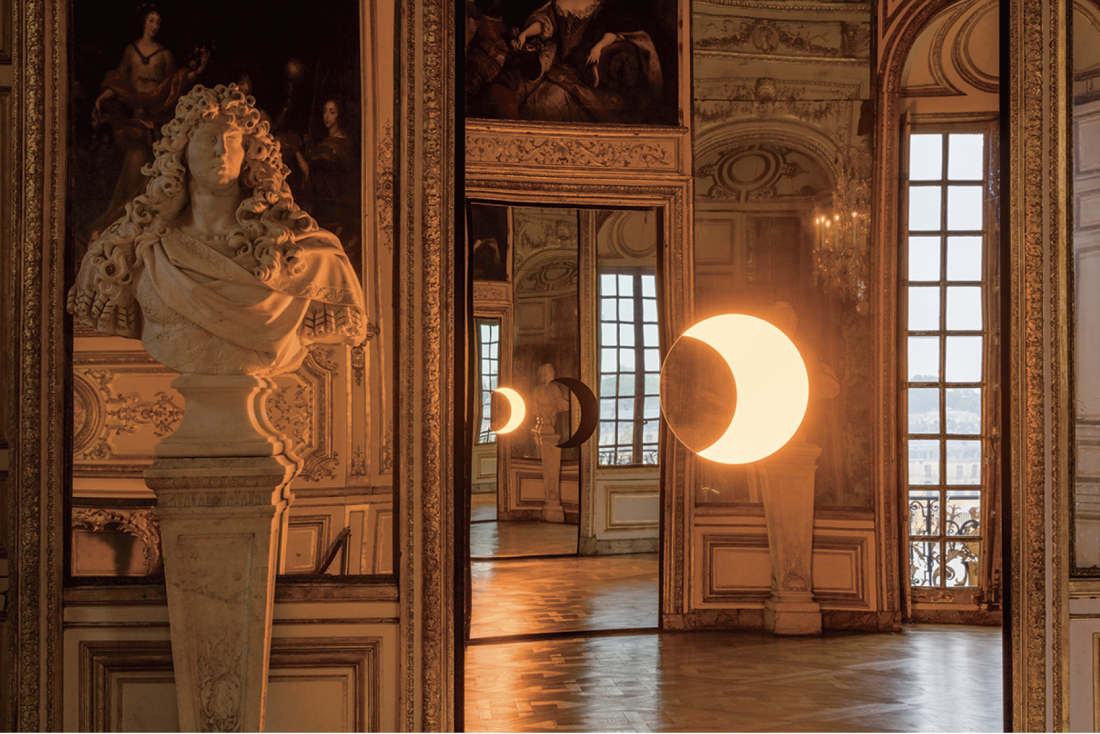Olafur Eliason
At the centre of the Palace of Versailles rest the stale remains of La Chambre du Roi (the King’s bedroom), the vestigial heart of pre-revolutionary France and the site from which Louis XIV’s absolute monarchy, echoing throughout the French territories, pronounced itself through dictum and edict. Likewise, the Palace’s design—its architecture, its gardens and even the surrounding city’s infrastructure— reinforce this centralization of power, a hallmark of Louis XIV’s rule, all radiating outward from the King’s box spring. Great consideration was spent on this spatial organization and on the surrounding styling and decor. The bedroom, as is true throughout the palace, is decorated with gold and marble, furnished in velvet and silk, and finished with painted ceilings and moulded reliefs. All this to exhibit the great affluence of the self described Sun King, validating his rule over France. Once the monarchy fell, though, the Palace was looted and much of what once made it glisten in Louis’s image was removed. And so it is today, semi-restored, wood painted to look like marble in each doorway, dusty tapestries cloistered behind acrylic panels.

Olafur Eliason, Waterfall, 2016, crane, water, stainless steel, pump system, hose, ballast. All photos: Andres Sune Berg.
Despite the contemporary state of the Palace, the style of Louis XIV remains an appealing one, especially to those desperate to overstate their standing within the world. It shouldn’t come as much of a surprise that weeks after the announcement of his campaign to be president, photos were leaked of Donald Trump’s three-story Trump Tower suite decorated in the style of Louis XIV. Despite the fact that the ideals upon which American democracy are founded are those that drove the revolution to overthrow Louis’s monarchy, Trump likely sees himself as a modern day Sun King, and much of the argument for his qualifications to be president are based on his singular achievements in business. Like the effect of the prop-like illusions now found at Versailles, Trump’s campaign caught on to the fact that for a sizeable portion of the American electorate surface and bluster are more important than policy, and a selfie in front of a painted wood archway is just as convincing as one in front of the the real thing.

Solar compression, 2016, convex mirrors, mono-frequency light, stainless steel, paint (white), motor, control unit.
Unfortunately Olafur Eliason’s installation at the Palace of Versailles suffers from these limitations as well. The works he has installed inside the palace struggle to extricate themselves from the artificiality of its amusement parklike surroundings. The four most obvious victims of this, beginning with Your sense of unity in the infamous Hall of Mirrors, and followed in quick succession by Deep mirror (black) and (yellow), and Solar compression, all give themselves too easily to their environment and risk becoming just the type of adornment in which Louis XIV might have liked to see himself reflected. All combine mirror and light—outside of the palace they might have more to offer—but in the context of the tourist attraction that is the Palace of Versailles they simply become selfie fodder, with school groups and families clamouring over one another to locate the best angles.

Deep mirror (yellow), 2016, mirror, monofrequency light, aluminium, steel, wood, paint (black, white), control unit.
Unlike the interior of the palace though, the gardens remain as spectacular as ever and it is within this spectacle that Eliason’s interventions are most successful. Again, there is little that Eliason does to subvert the grandiosity of the gardens, but unlike the works in the palace interior, outdoors the works are given some autonomy from their surroundings and function more like artworks than design elements. Most obviously, the towering Waterfall set just behind the existing Apollo Fountain matches and surpasses the grandeur of the landscape that contains it. Likewise, Fog assembly and Glacial rock flour garden pleasantly surprise and are somewhat disorienting at their sequestered locations in the labyrinthine gardens. The three outdoor works re-present the water features that punctuate the gardens as the three states of matter: gas (Fog assembly), liquid (Waterfall) and solid (Glacial rock flour garden). Whereas inside the palace the works too closely resemble the materials of their surroundings, this simple, subtle shift is enough to reactivate the entirety of the gardens in a contemporary light.
Admittedly, the thoughts above ignore Eliason’s own statements about his intentions for the Palace of Versailles installation, which include details regarding climate change and environmental awareness. Around Glacial rock flour garden there is a carpet of rock sediment generated by glacial erosion, the only overt allusion to this theme to be found on the property. Though these underlying intentions fit well within Eliason’s broader practice, in Versailles they become secondary to the spectacular backdrop against which these works compete. Outdoors, in the gardens, they succeed in doing so. Though cameras were most definitely out, I saw many more instances where they were then lowered, put away so as to no longer obstruct or fracture the view; the world returned to three dimensions, when an illusion wouldn’t suffice. ❚
Olafur Eliason was exhibited at the Palace of Versailles, France, from June 7 to October 30, 2016.
Aryen Hoekstra is an artist based in Toronto. He is a Contributing Editor at Towards.info and currently serves as the director of G Gallery.

